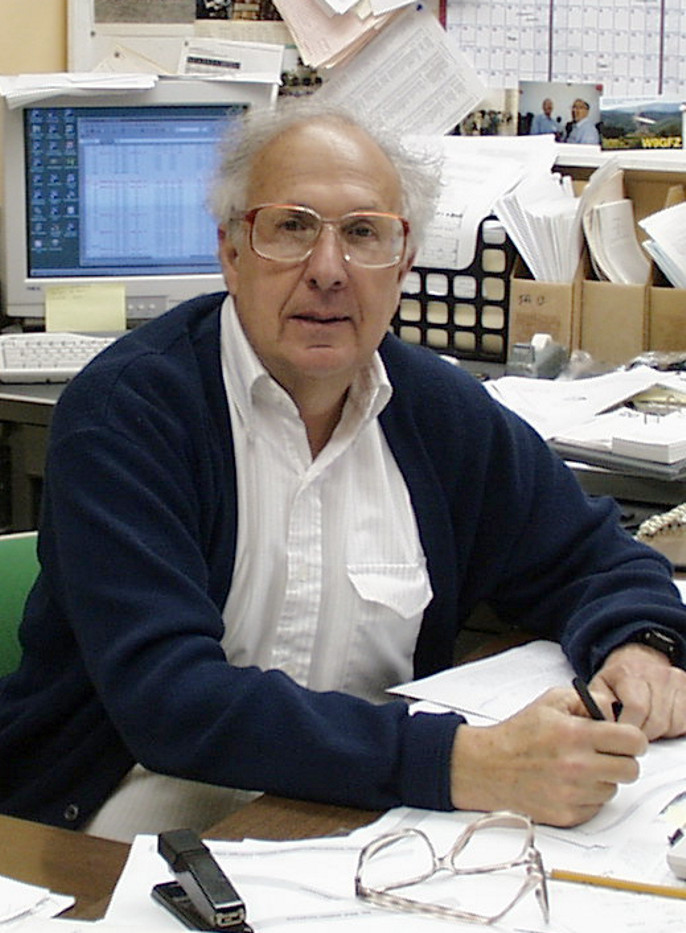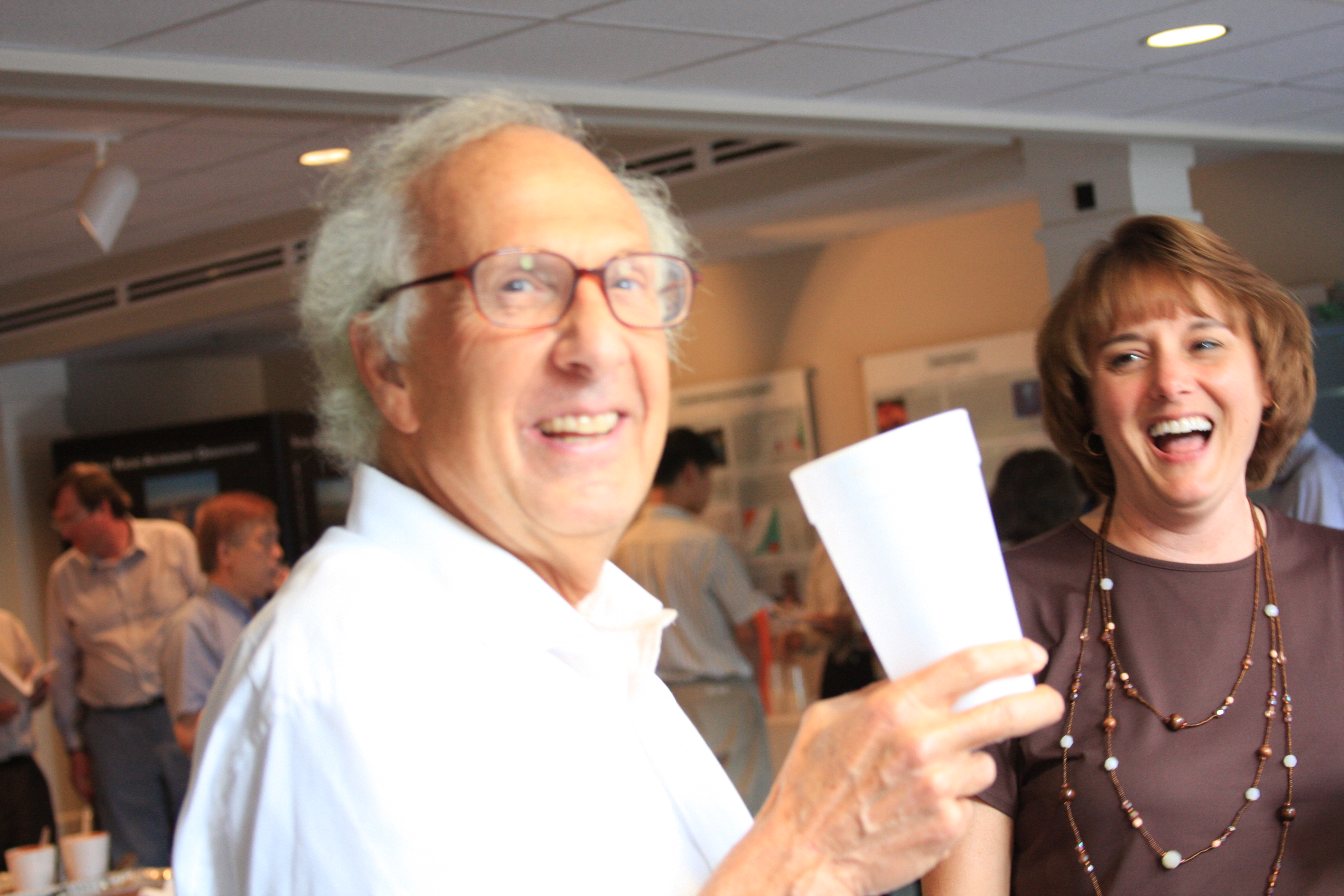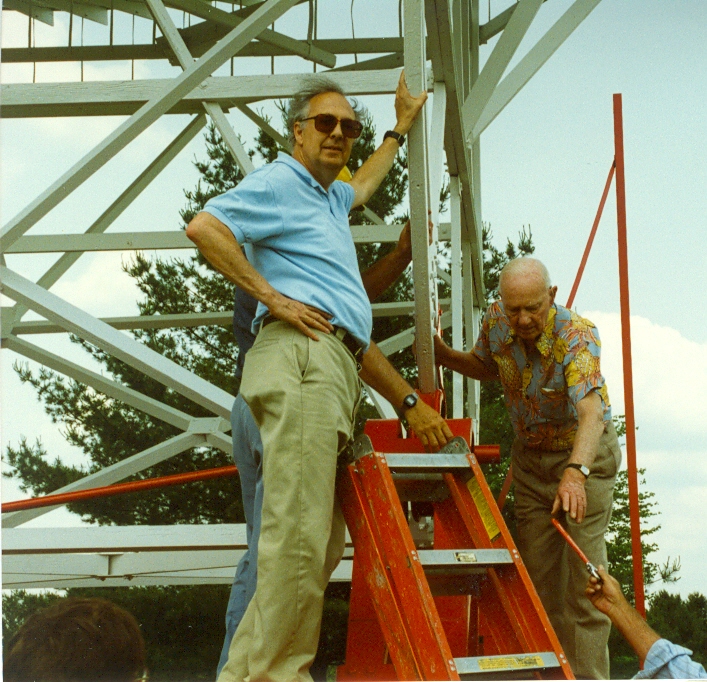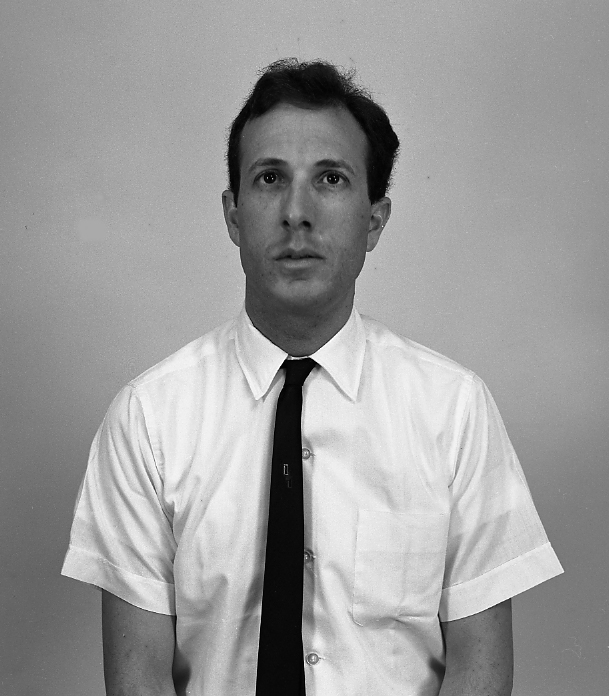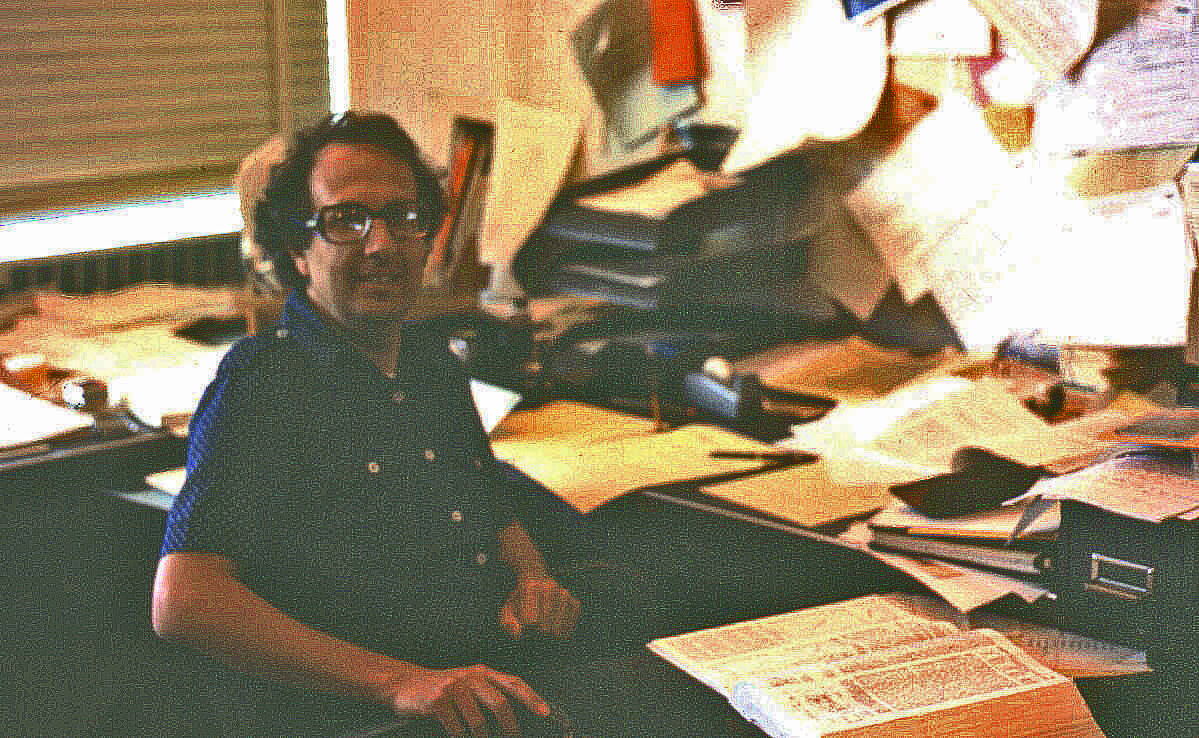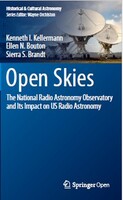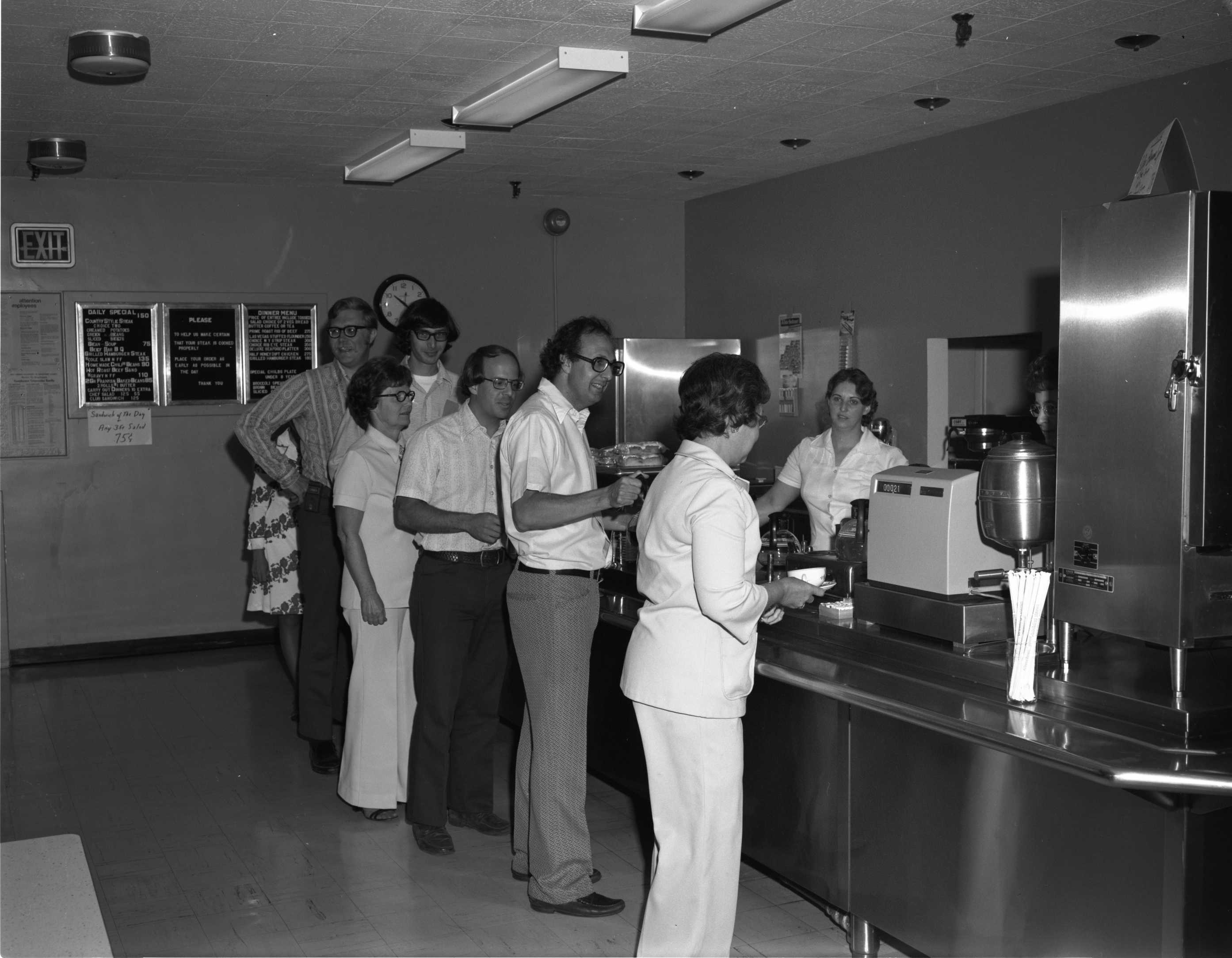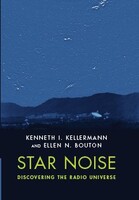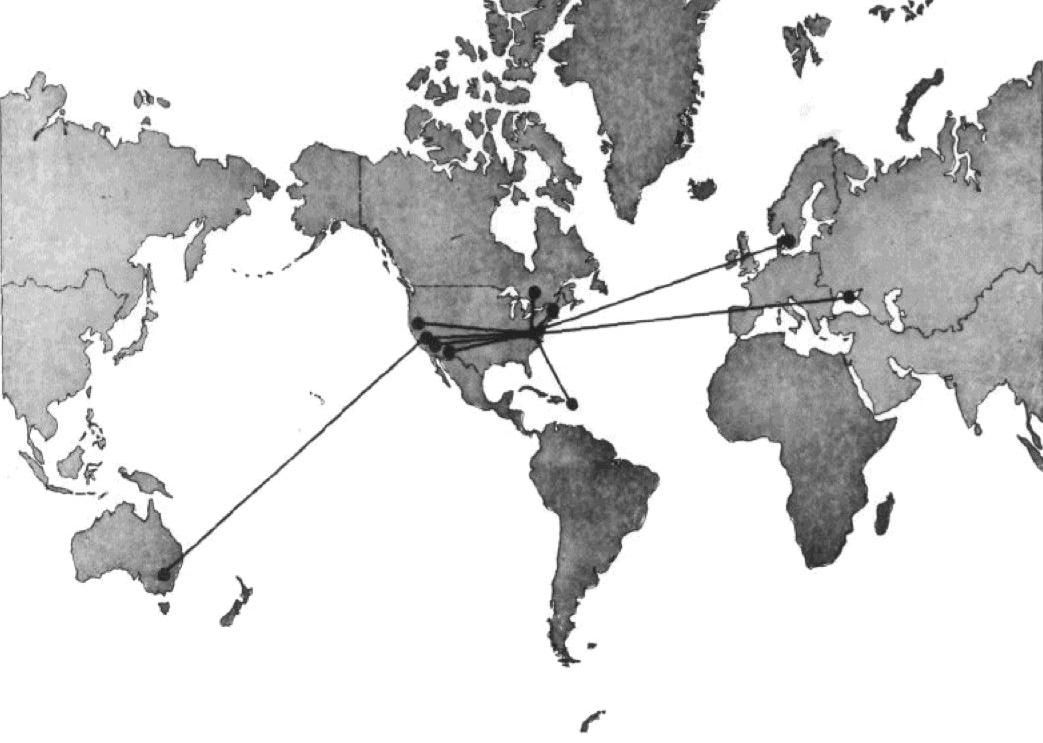|
See also the Papers of Woodruff T. Sullivan III, which include a 75 minute oral interview with Kellermann conducted in 1975, and the oral interviews conducted in 2016 by J. Holbrook and 2020 by R. Charbonneau in the collection of AIP's Neils Bohr Library.
Contents:
Click here for Kellermann's interviews with Bernard F. Burke, Frank D. Drake, David S. Heeschen, David E. Hogg, William E. Howard III, Theodore R. Riffe, and Campbell M. Wade.
Location of collection: National Radio Astronomy Observatory, Archives, 520 Edgemont Rd., Charlottesville, VA. Phone: 1-434-296-0367, email: archivist at nrao.edu
Title and dates of the collection: Papers of Kenneth I. Kellermann, 1965-2024
Size of the collection: 133 linear feet plus 17 audio cassette tapes and one DVD. (as of April 2025)
Papers/Records created by: Kellermann, Kenneth I. (1937- )
Short description of collection: This collection currently includes Kenneth I. Kellermann's papers related to VLBI, the VLBI Consortium, and the U.S. VLBI Network, on the history, early development, and construction of the Very Long Baseline Array (VLBA), the Square Kilometer Array, and materials related to the 1983 celebration of 50th anniversary of Karl G. Jansky's detection of radio waves from the center of the Milky Way, and materials related to Kellermann publications. Also included with the papers are NRAO correspondence, memos, reports, observing schedules, meeting announcements, meeting agendas, and technical data sheets from 1965-1993, and papers from his service on non-NRAO councils and committees. Further materials and topics will be added as additional donations are received.
Top
Selected search terms:
- Kellermann, Kenneth I., 1937-
- Jansky, Karl Guthe, 1905-1950
- Serendipitous discoveries in radio astronomy
- Square Kilometer Array
- Very long baseline interferometry
- Very Long Baseline Array
- U.S. VLBI Network
Top
Biography: Kenneth I. Kellermann is a Senior Scientist, Emeritus at the National Radio Astronomy Observatory where he works on the study of radio galaxies, quasars and cosmology, the development of new instrumentation for radio astronomy, and the history of radio astronomy. He also holds an appointment as a Visiting Professor at the University of Virginia and as an Outside Scientific Member of the German Max Planck Society.
Dr. Kellermann received his S.B. degree in Physics from Massachusetts Institute of Technology in 1959 and his Ph. D. in Physics and Astronomy from California Institute of Technology in 1963, where he is a Distinguished Caltech Alumnus. Following his Ph.D. he spent two years at the CSIRO Radiophysics Laboratory in Australia. Since 1965 he has been at NRAO except for extended leaves at Caltech as a Sherman Fairchild Distinguished Visitor, and in the Netherlands, Australia, and Germany. He has served as the Assistant Director at NRAO in 1977, as Chief Scientist from 1995-2003, as head of the NRAO New Initiatives Office from 2003 to 2007, and as Director at the Max-Planck-Institute für Radioastronomie in Bonn, Germany in 1977-79.
Dr. Kellermann is a member of the National Academy of Sciences, a Foreign Member of the Russian Academy of Sciences, a Fellow of American Philosophical Society and the American Academy of Arts and Sciences. He is a recipient of the Warner Prize of the American Astronomical Society, the Gould Prize of the National Academy of Sciences, the Rumford Medal of the American Academy of Arts and Sciences, and the Bruce Medal of the Astronomical Society of the Pacific. He is a member of the American Astronomical Society, the Astronomical Society of Australia, the International Radio Science Union, and the International Astronomical Union, where he served as President of the Commission on Radio Astronomy.
Dr. Kellermann was the former Chair of the NAS Astronomy Section, the USNC-IAU, the Radio Astronomy Panel of the 1990 National Research Council Astronomy and Astrophysics Survey Committee, the IAU Working Group on Historic Radio Astronomy and the International Square Kilometre Array Science and Engineering Committee. He has served on the Council of the National Academy of Sciences, on the NRC Board on Physics and Astronomy, the Commission on Physical Sciences, Mathematics, and Applications as well as other committees and panels of the AAS, NAS, NRC, NSF, IAU, URSI, NASA, and the European Space Agency.
He was the 2024 NRAO Karl G. Jansky Lecturer, and the co-author of two books on the history of radio astronomy, Open Skies: The National Radio Astronomy Observatory and its Impact on US Radio Astronomy, and Star Noise: Discovering the Radio Universe, and is editor or co-editor of other books on radio astronomy.
Minor Planet 152985 is named Kenkellermann.
[Biographical note written by Kenneth I. Kellermann.]
Top
Accession history: The first donation of materials in this collection was made in 2008; additional donations in 2010, 2012, 2015, and ongoing.
Top
Access to collection: No restrictions. Contact the Archivist for appointment.
Top
Restrictions on use of collection: None.
Top
Publication rights: Copyright has been assigned to the NRAO/AUI Archives. All requests for permission to publish or quote from manuscripts must be submitted in writing to the Archivist.
Top
Preferred citation: National Radio Astronomy Observatory/Associated Universities, Inc. Archives, Papers of Kenneth I. Kellermann, <series/unit/subunit/box #>. After the initial citation, abbreviations may be used: NRAO/AUI Archives, Kellermann Papers, <series/unit/subunit/box #>.
Top
Processing notes: Inventory of the initial donation for this collection was done in 2008 by Ellen N. Bouton, with final arrangement, description, indexing, foldering and boxing of that material completed in 2010. During the processing, photocopies were made to replace thermofax sheets and newspaper clippings, fasteners were removed, and materials were removed from binders of various types. At his request, duplicates were returned to Dr. Kellermann. Further additions to this collection are expected.
Top
Scope and Contents of Collection
Very Long Baseline Interferometry (VLBI) Series: This series contains materials dated 1965-1994 related to VLBI, the VLBI Consortium, and the U.S. VLBI Network. Included here are general materials including correspondence, notes, memos, reports, agendas, meeting minutes, meeting agendas, proposals, bylaws, and budgets. Topical materials on the European VLBI Network, satellite link radio interferometry, the Mark II processor, and VLBI reductions are also included, as well as a folder of material labeled by Kellermann as "VLBI History." Size: 0.5 linear feet. See below for specific units within this series. Click here for a folder listing. Related materials: see VLBI material in the Papers of Donald C. Backer, the Papers of Marshall H. Cohen and in the Records of the National Radio Astronomy Observatory.
- Network Users Group Unit: This unit includes VLBI Network Users Group correspondence, memos, schedules, reports, newsletters, and other materials dated 1974-1985. Primary authors are Donald C. Backer, Marshall H. Cohen, Kenneth I. Kellermann, James M. Moran, Paul B. Sebring, David B. Shaffer, and George W. Swenson. Size: 0.5 linear feet. Click here for a folder listing. Related materials: For other materials on the Network Users Group, see the Very Long Baseline Interferometry Series in the Papers of Marshall H. Cohen and in the Records of the National Radio Astronomy Observatory.
- Space VLBI Unit: Space VLBI materials from 1982-1994. Size: 4.25 linear feet Click here for a folder listing. Related materials: See also materials in the Records of National Radio Astronomy Observatory, the Papers of Robert L. Brown, and the Papers of Bernard F. Burke. This unit also includes the following:
- RadioAstron Subunit: Click here for a folder listing.
- Quasat Subunit: Click here for a folder listing.
- VSOP Subunit: Click here for a folder listing.
- Early VLBI Experiments Unit: This unit includes material dated 1968-1971 on early VLBI experiments other than the US-USSR experiments in the separate US-USSR VLBI Experiments Unit. Size: 0.25 linear feet. Click here for a folder listing. Related materials: See early VLBI materials in the Papers of Barry G. Clark.
- US-USSR VLBI Experiments Unit: The first US-USSR VLBI experiments, between the NRAO 140 foot telescope in Green Bank WV and a 22 meter USSR telescope in Crimea were conducted in September and October 1969, with follow-up experiments in 1971. This unit contains correspondence, equipment export applications and shipping documents, as well as more general notes on research in the USSR. Material is dated 1968-1979. Size: 1.0 linear feet. Click here for a folder listing and digitized documents. Related materials: For other materials on the early US-USSR VLBI experiments, see both the Green Bank Chronological Correspondence Subunit and the Very Long Baseline Interferometry Series in the Records of the National Radio Astronomy Obserservatory, the folder on VLBI History in the Kellermann VLBI Series above, as well as the articles by Kellermann and by Barry Clark in NRAO's newsletter, The Observer, between 1970-1972.
Top
Very Long Baseline Array (VLBA) Series: The Very Long Baseline Array consists of ten, 240-ton, 25-meter diameter dish antennas spread across the Western Hemisphere, from Hawaii to St. Croix, Virgin Islands; it is a facility of National Radio Astronomy Observatory. Construction began in February, 1986, and was completed in May, 1993. This series includes materials on the history, development, and construction of the VLBA. Related materials: See also the working notebooks on VLBA in the Working Notebooks Series below. For other materials on the VLBA see the Records of the National Radio Astronomy Observatory, the Papers of Marshall H. Cohen, the Papers of Paul A. Vanden Bout, and the Papers of A. Richard Thompson.
- VLBA History and Development Unit: This unit contains material on background, early discussions, and planning for the VLBA, design studies and drafts leading to the formal VLBA proposal to the National Science Foundation in 1982, and materials related to the construction process and ongoing planning and design. Included are correspondence, memos, reports, notes, reprints, meeting announcements and notes, and material from the 1984 VLBA Review Panel. Material is dated 1965-1985. Size: 2.0 linear feet. Click here for a folder listing.
- VLBA Antennas Unit: This unit contains materials dated 1980-1992 on the selection of a company to build the 10 VLBA antennas, and includes the March 1984 formal Request for Proposals, VLBA Antenna RFP Information Bulletins, Subcontract VLBA-100 (Design, Manufacture, and Transportation of Ten Radio Telescope Antennas, December 1984), Subcontract VLBA-101 (Assembly and Testing of Ten Radio Telescope Antennas, December 1984), as well as notes, memos, and correspondence on the RFP process, on meetings with bidders, and evaluation of the bids. The bulk of the material is dated 1983-1985. Size: 0.5 linear feet plus 6 blueprints (stored in the flat file case).
- VLBA Antenna Locations and Configurations Unit: This unit contains notes, memos, correspondence, figures, and maps dated 1979-1985 related to the selection of geographic locations and configurations for the antennas. Size: 0.25 linear feet.
- VLBA Budget Unit: This unit contains VLBA budget materials dated 1979-1985. Size: 0.25 linear feet.
- VLBA Coordinating Committee Unit: The VLBA Coordinating Committee was composed of heads of the various working divisions, and was chaired by NRAO Associate Director Hein Hvatum. This unit includes numbered memos 1-55 (September 1983 - May 1985), lacking memos 26, and 39. Size: 0.25 linear feet.
- VLBA Correlator Unit: This unit contains materials dated 1980 through June 1986 on the design and construction of the VLBA correlator, and includes notes, memos, correspondence, and diagrams. Size: 0.25 linear feet.
- VLBA Recording System Unit: This unit contains material dated 1975-1986 on the VLBA recording system, and includes notes, memos, correspondence, and diagrams. Size: 0.5 linear feet.
- VLBA Working Groups Unit: This unit contains correspondence, memos, notes, and reports dated 1979-1984 from VLBA working groups on antennas, computing, data transfer, electronics, front end, local oscillator, monitor and control, operations, post-processing, recorder, science, and site. Size: 0.75 linear feet.
- VLBA Related International Projects Unit: This unit contains materials dated 1979-1986 on the Canadian Very Long Baseline Array, as well as one folder of 1984 materials on the Australia Telescope. Size: 0.25 linear feet.
- MOJAVE Unit: Materials on MOJAVE (Monitoring of Jets in AGN with VLBA Experiments) dated 2005- . Size: 0.25 linear feet.
- VLBA Miscellany Unit: This unit contains general VLBA correspondence dated 1980-1987, as well as material that did not fit in any of the above units, including one folder dated 1980-1984 on computing, two folders dated 1980-1984 on masers, one folder dated 1984 on VLBA operations, and one folder of newspaper and magazine articles about the proposed instrument dated 1974, 1980-1982, 1993. Size: 0.25 linear feet.
Top
Square Kilometer Array (SKA) Series: This series includes materials dated 1997-2019 collected by Kellermann during his involvement in both the International SKA and the US SKA Consortium. The series is divided into two units, one for International SKA and one for the US SKA Consortium (USSKAC). Related material: See also material on the SKA in the Papers of Bernard F. Burke.
- International Square Kilometer Array (SKA) Unit: Discussions about a square kilometer array began around 1990 in both the UK and the Netherlands and was discussed by Peter Wilkinson at the 1991 VLA 10th anniversary symposium in Socorro, NM. In 1993, URSI established a Large Telescope Working Group which included National Radio Astronomy Observatory (NRAO) scientist A. Richard Thompson. Kenneth I. Kellermann became involved a few years later. In 1997, eight countries, including the US, signed a Memorandum of Agreement to cooperate on technology studies leading to a future large radio telescope. At the August 2000 International Astronomical Union (IAU) General Assembly in Manchester, UK, 11 countries signed a Memorandum of Understanding establishing the International Square Kilometer Array (SKA) Steering Committee (ISSC). In October 2007, the ISSC signed an agreement with the University of Manchester to host the International SKA Project Office (ISPO) and Richard Schilizzi became the first ISPO Director. A new agreement led to the establishment of the SKA Science and Engineering Committee (SSEC) which replaced the ISSC effective Jan 1, 2008 and established the SKA Program Development Office (SPDO) replacing the ISPO. Kellermann became Vice Chair of the SSEC and in 2010 and 2011 he served as SSEC Chair. During this period the SSEC, in collaboration with a separate committee composed of representatives from government agencies, established a number of committees dealing primarily with the costing and legal arrangements for the SKA. The ISSC and SSEC generally met twice a year. Following the 2010 NAS Decadal Review of Astronomy, which did not endorse the SKA, the NSF did not join the not-for-profit SKA Organization which was formed at the end of 2011, leading to the end of any formal involvement by the US in the SKA program.
- International SKA Steering Committee (ISSC) / SKA Science and Engineering Committee (SSEC) Subunit: This subunit includes correspondence, notes, agendas, minutes, reports, meeting presentations, resolutions and other materials related to the ISSC (1997-2007) and its successor, the SSEC (2008-2011). Kellermann was chair from 2008-2010 and served on the Executive Committee until the SSEC was disbanded in 2011. Size: 4 linear feet. Click here for a folder listing.
- Agencies SKA Group (ASG) / International Funding Agencies Group (IFAG) Subunit: Starting in 2006, representatives from the various international funding agencies, including the NSF (represented by Pankonin and later Ulvestad) held their own meetings. The ASG/IFAG was made up of representatives of the science agencies or ministries of the participating countries and met independently at the time of ISSEC/SSEC meetings. Agendas, correspondence, reports, organizational materials dated 2009-2010. Size: 5 folders. Click here for a folder listing.
- International Engineering Advisory Committee (IEAC) Subunit: Correspondence, meeting agendas and reports. Size: 2 folders. Click here for a folder listing.
- International SKA Project Office (ISPO) / SKA Project Development Office (SPDO) Subunit: Material dated 2002-2011 includes correspondence, materials on director search, proposals to host the ISPO/SPDO and a report of the site selection committee. Size: 3 folders. Click here for a folder listing.
- Low Frequency Array (LOFAR) Subunit: LOFAR was a spinoff of the SKA and was planned to be a multi-element, interferometric, imaging telescope designed for the 10-240 MHz range. After considering potential sites in Australia and the US, the Dutch obtained national funding and LOFAR was built in the Netherlands. MIT, the University of New Mexico, NRAO and NRL discussed a US version of LOFAR. UNM formed the South West Consortium which led to the construction of the Low Frequency Array (LWA) in New Mexico. MIT partnered with Australia to build the Murcheston Widefield Array (MWA) in Australia. Kellermann was a member of the LOFAR Science Consortium Board. This subunit includes correspondence, reports, meeting agendas and presentations, proposals from 1998-2006. Size: 0.75 linear feet. Click here for a folder listing.
- Operations Working Group (OWG) Subunit: The Operations Working Group was formed to examine operating scenarios for the SKA, and, in particular, to determine how the optimum SKA operation might impact the SKA design and construction. Kellermann was the chair of the OWG. This subunit includes correspondence, reports, proposals and presentations dated 1997-2010. Size: 0.5 linear feet. Click here for a folder listing.
- Tiger Teams Subunit: Correspondence, white papers, reports and other material from the following: Specs Tiger Team (1995-2008), Options Tiger Team (2004-2015) and Infrastructure Tiger Team (2006-2007). Size: 5 folders. Click here for a folder listing.
- Preparatory SKA (PrepSKA) Subunit: The European SKA Program was funded under two grants from the European Commission to Promote European Scientific Infrastructure. The Preparatory SKA (PrepSKA) program was funded through the EC Framework Program 7 (FP7). Various PrepSKA work packages (WPs) were devoted to governance, funding, schedule, siting, procurement and design. Kellermann and other US scientists participated in the PrepSKA WPs. NSF and other agency representative4s took part in the programmatic WPs. SKADS and PrepSKA had a greater impact on the SKA effort than did the US TDP program. Material dated 2006-2011. Size: 1.0 linear feet. Click here for a folder listing.
- Science and Engineering Planning Subunit: Correspondence, reports and workshop materials dated 2000-2009. Size: 5 folders. Click here for a folder listing.
- Site Selection Subunit: Material relating to site proposals and selections, including working group notes and reports. Material dated 2004-2017. Size: 0.5 linear feet. Click here for a folder listing.
- SKA Design Study (SKADS) Subunit: The European SKA Program was funded under two grants from the European Commission to Promote European Scientific Infrastructure. SKA Design Study (SKADS) was led by Arnold Van Ardena from the Netherlands under the EC Framework Program 6 and focused on the design of aperture arrays through eight design studies from 2006-2009. SKADS and PrepSKA had a greater impact on the SKA effort than did the US TDP program. Material dated 2006-2009. Size: 0.5 linear feet. Click here for a folder listing.
- SKA History Subunit: This subunit includes presentations, notes and other material from a meeting on the history of the SKA held in Manchester, UK in April 2019. It also includes papers related to key events in the history of the SKA and SKA promotional material. Size: 0.5 linear feet. Click here for a folder listing.
- Misc. Material Subunit: This subunit includes the following: SKA newsletters (2004-2008), director performance evaluations (2003-2006), guidelines for in-kind contributions (2009), Power Investigation Task Force (2009-2010), Definition Subcommittee (2010). Size: 7 folders. Click here for a folder listing.
- US Square Kilometer Array Consortium (USSKAC) Unit: U.S. involvement in the SKA began in October 1998 with a meeting held in Green Bank organized by Kellermann and J. Richard Fisher that led to the establishment of the US SKA Consortium (USSKAC). Initially NRAO did not join USSKAC, but Kellermann and Fisher became At-Large members. When NRAO joined the consortium in 2000, Kellermann remained as one of the two NRAO representatives. Chairs of the USSKAC included Jacqueline N. Hewitt from MIT, Jill Tarter from the SETI Institute, followed by Yervant Terzian and James M. Cordes from Cornell. This unit contains minutes of USSKAC meetings and related correspondence from 1998 until the consortium was dissolved in 2011. Also included is material relating to NRAO and Associated Universities, Inc. interactions with the USSKAC as well as USSKAC interactions with the National Science Foundation (NSF) and 2011 National Academy of Sciences (NAS) Decadal Review process. Size: 2 linear feet. Click here for a folder listing.
- US Technology Development Program (TDP) Subunit: Until 2011 Cornell University remained the legal entity representing the United States in the International SKA program. Consortium activities, including various technical development programs, were funded by several NSF grants totaling about $12M and were administered by Cornell University. This subunit contains notes and correspondence related to the US Technology Development Program led by Jim Cordes at Cornell. Size: 0.5 linear feet. Click here for a folder listing.
Top
Search for Extraterrestrial Intelligence (SETI) Series: Kellermann participated in the 1971 Symposium on the Problem of Communication with Extraterrestrial Civilizations (CETI Conference) held in the USSR and was a member of the US-based SETI Science Working Group in the 1980s and the SETI Science and Technology Working Group in the 1990s. Included in this series are: agendas and reports from these groups; articles and newspaper clippings on SETI; correspondence; and assorted publications from NASA’s SETI program and the SETI Institute. Also included are documents relating to US Congressional funding of SETI. Records date from 1953-2025. Size: 2.0 linear feet. Click here for a folder listing.
Top
Decade Reviews Series: Every ten years the Astronomy and Astrophysics Survey Committee (AASC) of the National Research Council surveys the field of space- and ground-based astronomy and astrophysics, recommending priorities for the most important new initiatives for the next decade. The Committee is comprised of several specialized panels of astronomers and astrophysicists who meet over the course of a year to survey and report on the status of their field and to rank projects for the upcoming decade.
- 1990 Decade Review Unit: Kellermann chaired the Radioastronomy Panel of the AASC for the 1990 Decade Review. This unit includes agendas, minutes, presentations and reports from AASC and Radio Panel meetings in 1989 and 1990. It includes correspondence with Panel members, astronomy colleagues and foreign consultants. It includes correspondence and material submitted by the various organizations and groups who wished to have their projects considered for inclusion in the final report. There is also correspondence and presentations relating to the other panels of the AASC. Size: 3 linear feet. Click here for a folder listing.
- 2000 Decade Review Unit: Kellermann served as a member of the Panel on Radio & Submillimeter-wave Astronomy for the 2000 Decade Review. This unit includes agendas, minutes and presentations from AASC and Radio Panel meetings in 1999 and 2000. It also includes correspondence and material submitted by the various organizations and groups who wished to have their projects considered for inclusion in the final report. Size: 1.5 linear feet. Click here for a folder listing.
Top
National Radio Astronomy Observatory (NRAO) Memos and Reports Series: This series includes NRAO correspondence, memos, reports, observing schedules, meeting announcements, meeting agendas, and technical data sheets from 1965-1993. Folders are arranged chronologically, with undated items retained at the back of the dated folder in which they were originally filed. Size: 1.5 linear feet.
Top
Councils and Committees Series: This series includes materials related to Kellermann’s service on non-NRAO councils and committees, and has been divided into the following units.
- National Academy of Sciences (NAS) Unit: This unit includes materials related to Kellermann’s service on NAS councils and committees from 1977 through 2019. Included are meeting materials, notes, and correspondence. Size: 13 linear feet. This unit has been divided into the following subunits.
- Space Studies Board Subunit: Click here for a folder listing.
- BISO Subunit: Click here for a folder listing.
- Board on Physics and Astronomy (BPA) Subunit: Click here for a folder listing.
- Committee on Astronomy and Astrophysics (CAA) Subunit: Click here for a folder listing.
- Committee on Physical Sciences, Mathematics and Applications (CPSMA) Subunit: Click here for a folder listing.
- Committee on Smithsonian Scientific Research (CSSR) Subunit: Click here for a folder listing.
- Committee on Radio Frequencies (CORF) Subunit: Click here for a folder listing.
- U.S. National Committee for the International Astronomical Union (USNC-IAU) Subunit: Click here for a folder listing.
- Miscellaneous NAS Committees Subunit: Includes committees for which there is minimal material: USNC-URSI, ISTEG. Click here for a folder listing.
- NAS General Subunit: Click here for a folder listing.
- National Aeronautics and Space Administration (NASA) Astrophysics Council Unit: This unit includes materials related to Kellermann's service on the NASA Astrophysics Council, also known as the Astrophysics Management Operations Working Group, in 1986-1987. Size: 0.5 linear feet. Click here for a folder listing.
- National Science Foundation (NSF) Unit: This unit includes materials related to Kellermann's service on the NSF Astronomy Advisory Committee from 1977-1981 and an AURA Management Review in 2000. Size: 0.5 linear feet. Click here for a folder listing.
- International Astronomical Union Historical Radio Astronomy Working Group Unit: This unit includes correspondence, presentations, and other materials related to the IAU Historical Radio Astronomy Working Group beginning in 2003. Size: 0.25 linear feet. Related materials: see the WG Web page.
- Northeast Radio Astronomy Corporation (NEROC) Unit: This unit includes materials related to Kellermann's service on the Board of Trustees for NEROC. Materials include agendas, handouts, minutes and correspondence. Size: 2 linear feet. Click here for a folder listing.
- Committee to Support Astronomy in the Former Soviet Republics Unit: Following the fall of the Soviet Union, the American Astronomical Society formed a committee to provide financial and other support to scientists in the FSU. In December 1992, George Soros established the International Science Foundation for the Former Soviet Union and committed $100 million to scientific support. This unit includes Kellermann's correspondence and meeting notes relating to his involvement in both groups. Material dates from 1992-1994. Size: 0.5 linear feet. Click here for a folder listing.
- Grote Reber Medal Unit: The Grote Reber Gold Medal for innovative contributions to radio astronomy was established by the Trustees of the Grote Reber Foundation to honor the achievements of Grote Reber and was administered by the Queen Victoria Museum in Launceston, Tasmania in cooperation with the NRAO, the University of Tasmania, and the CSIRO Australia Telescope National Facility. The Medal was awarded annually from 2005 through 2014. Kellermann co-administered the award. Size: 0.5 linear feet. Click here for a folder listing.
- Miscellaneous Councils and Committees Unit: This unit includes materials related to Kellermann's service for the Naval Research Laboratory, MIT and other organizations. Size: 1.0 linear feet. Click here for a folder listing.
Top
Kellermann Publications Series: This series includes a full bibliographic listing of Kellermann publications, reprints of the majority of his publications in the open literature, and materials utilized in the research, writing, and publication of Open Skies (2020) and Star Noise (2023).
For a complete listing of Kellermann publications, click here.
- Kellermann Reprints Unit: This unit includes reprints of Kellermann articles in the open literature, including refereed, invited and review, conference, and popular articles, as well as obituary articles and book reviews. Research and background materials are filed with some reprints. Reprints are dated 1962-2024. Size: 1.0 linear feet.
- Brief History of Radio Astronomy in the USSR Unit: Kellermann was the editor of the English translation of A Brief History of Astronomy in the USSR, published by Springer in 2012. Size: 1 folder. Click for a listing.
- Open Skies Unit: This unit includes research, primary sources, correspondence, presentations, reprints, theses, and other documentation and materials utilized for the book Open Skies by Ken I. Kellermann, Ellen Bouton, and Sierra Brandt. Size: 10.75 linear feet. Click here for an itemized chronological listing of archival materials gathered for Open Skies research included in the subunits below. This unit has been divided into the following subunits.
- Chapters Seven and Eight: the Very Large Array and Very Large Baseline Array Subunit: Documents and research centered on the conceptualization, oversight, and construction of the VLA and VLBA projects. Click here for a folder listing.
- Chapter Ten: Milimeter Array and Atacama Large Milimeter Array Subunit: Documents and research centered on the conceptualization, oversight, and construction of what eventually became ALMA. Click here for a folder listing.
- Primary Sources Subunit: Primary source documents from the NRAO/AUI Historical Archives as well as several other archives. Click here for a folder listing.
- Historical Correspondence Subunit: Letters, memos, and other primary source documents between entities and individuals. Click here for a folder listing.
- Emails and Correspondence Subunit: Emails and correspondence centered on the research, publication, and editing processes for Open Skies. Click here for a folder listing.
- Reference Materials Subunit: Secondary documents, additional histories, and general research materials, including requests for outside archival access and identification of archival holdings of original documents. Click here for a folder listing.
- Presentations and Lectures Subunit: Click here for a folder listing.
- Star Noise Unit: This unit includes correspondence, presentations, reprints, theses, and other documentation and research materials utilized for the book Star Noise by Ken I. Kellermann and Ellen Bouton. Materials are sorted by chapter. Size: 3.0 linear feet. Click here for a document listing.
Top
Conferences and Talks Series: This series is divided into the following units.
- Conference Proceedings Unit: This unit includes correspondence, notes, agendas, reports, resolutions, and other materials for conferences, workshops, and symposia that Kellermann attended from 1968 forward. Materials from the 1963 and 1971 SETI conferences in Byurakan are filed with the SETI Series above. Size: 3.5 linear feet. Click here for a folder listing.
- Talks Unit: Click here for a folder listing.
- NAS Colloquium Unit: Kellermann and Marshall Cohen organized a NAS Colloquium on "Quasars and Active Galaxies: High Resolution Radio Interferometry" held in Irving, CA from 24-25 March 1995. Included in this unit is the colloquium proposal, agenda, finances, correspondence and published proceedings. Click here for a folder listing.
- Conference Photographs Unit: Includes photographs from conferences attended by Kellermann.
- Radio Astronomy at the Fringe Subunit: Photographs from Radio Astronomy at the Fringe, held 10-12 October 2002 in Green Bank, WV to honor of Kenneth I. Kellermann on the occasion of his 65th birthday. Click here for selected images from a larger set; contact the Archivist for additional images.
Top
Jansky 50th Anniversary Celebration Series: Karl G. Jansky's detection of radio waves from the center of the Milky Way was announced on the front page of the New York Times on 5 May 1933. This series includes materials related to the anniversary celebrations at National Radio Astronomy Obervatory, and is divided into two units.
- Serendipitous Discoveries in Radio Astronomy Unit: The workshop titled Serendipitous Discoveries in Radio Astronomy was held at National Radio Astronomy Observatory in Green Bank WV on 4-6 May 1983. The meeting honored the 50th anniversary of Karl G. Jansky's announcement on 5 May 1933 of the discovery of cosmic radio waves. This unit includes material from 1982-1985: correspondence, notes, and planning documents for the meeting, press clippings, photos, transcripts of some of the talks, and a copy of the published proceedings. Many members of the Jansky family attended the workshop, and the correspondence includes letters from Jansky family members, many with reminiscences about Karl Jansky. Audio cassette tapes (sides 14 and 16 of 36 sides missing) recorded at the meeting are included, along with a digitized version of the tapes transferred to DVD in 2009. Size: 0.25 linear feet plus 17 audio cassette tapes and one DVD. Click here for a folder listing.
- Jansky Antenna Project Unit: This unit includes materials on the commemoration of the 50th anniversary of Karl Jansky's detection of radio waves from the center of the Milky Way by using the replica of Jansky's antenna at NRAO in Green Bank to operate on the amateur radio 15-meter band for 24 hours on 7-9 May 1983. Materials include sample QSL cards sent out by NRAO, Jansky Project memos, photocopies of articles relevant to Jansky's work (1930-1979), photocopies of articles by Jansky (1932-1935), correspondence, and Albert C. Beck's memo to file on construction of the Jansky antenna replica. The Beck memo includes figures and photographs. The amateur radio event was held at the conclusion of a symposium, Serendipitous Discoveries in Radio Astronomy, honoring the anniversary of Jansky's discovery. A second related amateur radio event on 13-15 May 1983 used the NRAO 140 Foot Telescope for 70 cm EME operations for which there is a scrapbook of QSL cards received. Material is dated 1930-1983. Related materials: see also materials on the Jansky antenna, including 1963 Bell Laboratories scale drawings for the antenna reconstruction, in the Records of the National Radio Astronomy Observatory. Size: 1.0 linear feet plus 1 scrapbook. Click here for a folder listing.
Top
John G. Bolton Series: John G. Bolton started the radio astronomy program at Caltech and was Kellermann's PhD thesis advisor at there until he returned to Australia in December 1960. After receiving his PhD from Caltech in June 1963, Kellermann had a postdoctoral appointment with Bolton at the CSIRO Radiophysics Lab. This series is comprised of correspondence and other material that Kellermann collected about Bolton. Size: 0.25 linear feet. Click here for a folder listing.
Top
Grote Reber Series: This series includes Kellermann's materials on Reber, including correspondence with and about Reber, materials on the Reber papers in the NRAO/AUI Archives, photographs, articles about Reber, and materials related to Kellermann's research on Reber. Size: 0.5 linear feet. Click here for a folder listing.
Top
Working Notebooks Series: This series includes Kellermann's working notebooks. Notebooks are for the period 1980-2014. See also notebooks from various conferences in the Conference Proceedings Unit. Size: 0.5 linear feet (10 notebooks). Click here for a folder listing.
Top
Oral Histories Series: This series includes oral interviews conducted by Kellermann between 2010 and 2023 with Michael Balister, Bernard F. Burke, Fred Crews, Frank Drake, Cyril Hazard, David S. Heeschen, David E. Hogg, William E. Howard III, Harvey Liszt, Thomas A. Matthews (interviewee permission required), T. Kochu Menon, Marcus Price, Grote Reber, Theodore R. Riffe, Paul A. Vanden Bout, Campbell M. Wade, and Sander Weinreb. Also included are transcripts of two interviews with Kellermann conducted by the AIP Center for the History of Physics. Click here for a listing of transcripts available on the Web; paper copies of transcripts are shelved with Kellermann's papers. Contact the Archivist for interviews not posted on the Web.
Top
Photographs Series: This series includes photographs of and collected by Kellermann. Click here for a folder listing and digitized photos.
Top
Miscellany Series: This series currently includes a folder of miscellaneous news clippings and Kellermann's copy of the synchrotron radiation lecture notes delivered at the Australian National University by Professor A.A. Sokolov in December 1963.
Top
|
